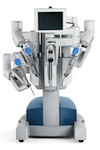Is there a role for robotic surgery in endometriosis?
By John Steege and Philippe Koninckx
Can the robot do laparoscopic surgery for the treatment of endometriosis better than current laparoscopic practices?
Two laparoendoscopic surgeons provide their experienced views on why we should wait for data, rather than respond to marketing claims.
 A little over 10 years ago, the Food and Drug Administration (FDA) in the United States approved the use of the surgical robot to assist in the performance of laparoscopic surgery.
A little over 10 years ago, the Food and Drug Administration (FDA) in the United States approved the use of the surgical robot to assist in the performance of laparoscopic surgery.
By that time, operative laparoscopy had come to be the predominant approach for some kinds of surgery (cholecystectomy, appendectomy, tubal sterilisation, treatment/removal of ectopic pregnancies, etc.) (Footnote: After FDA approval, instrument manufacturers are subject to almost no monitoring of marketing claims.)
Techniques for laparoscopic hysterectomy were developed in the late 1980s, but 15 years later, in the early 2000s, only about 12-15% of hysterectomies were done laparoscopically in the United States.
In many countries in Europe, laparoscopic hysterectomy was adopted at a more brisk pace. For example, in Germany, about 60% of hysterectomies are done laparoscopically.
Enter the robot, approved for use in gynaecologic surgery in the US in 2005. What should its role be in gynaecologic surgery? Can it do laparoscopic gynaecologic surgery in general, and treatment of endometriosis in particular, better than regular “traditional” laparoscopy?
Surgical expertise comes with experience
The aspects of a surgical procedure that result in quick and widespread adoption of a laparoscopic technique include the relative difficulty of the surgical task and the annual volume done by the typical surgeon.

Professor John Steege
For example, laparoscopic cholecystectomy is relatively simple, involving the division of the cystic duct, the cystic artery, a few veins, and some connective tissue; the difficulty varies relatively little from one case to the next. The average general surgeon does many of these each year.
Within 5 years of the debut of laparoscopic cholecystectomy, well over 50% of surgeries were done with this technique, to the great benefit of patients. A slightly less clear, but similar, case can be made for laparoscopic appendectomy and for ectopic (tubal) pregnancies.
However, gynaecologic surgeries are more variable in the challenges they present:
- fibroids can be large or small, few or many, and can be in peculiar places;
- endometriosis can vary over a wide range of severity, only some of which can be measured by pelvic examination or imaging prior to surgery;
- adhesions or scar tissue from infection or previous surgery can also vary widely in degree, and usually cannot be seen at all well on imaging studies (ultrasounds, CT scans, MRIs).
In the USA, this issue, together with the fact that the average practicing gynaecologist performs only about a 12-15 major surgeries yearly, has slowed the adoption of minimally invasive surgical techniques.
So, does the robot aid gynaecological surgery?
The introduction of robotics to gynaecologic surgery has no doubt brought wider public attention to the advantages of laparoscopic surgery.
While this seems to have increased the proportion of surgeries done laparoscopically, the process of introducing robotics has given rise to a number of myths, none of which has any supporting evidence in the literature:
| Myth | Fact |
|---|---|
| The 3-D vision of the robotic system helps. | Most experienced laparoscopic surgeons do not feel it helps much, if at all. Certainly, there is no demonstration that it increases speed or safety. |
| The 3-D vision of the robot allows the surgeon to see up to 30% more endometriosis. | This comes from a few surgeons, but has been promulgated publicly by the manufacturer. No valid scientific comparisons have been made or published. |
| When endometriosis is removed by robotic assisted laparoscopy, it recurs less often and more slowly. | This kind of claim would take a very careful long term study to investigate. No such study has been done. |
| Robotic assisted laparoscopy results in less post- op pain and faster recovery. | Compared to open (laparotomy) surgery, this is true. Compared to regular laparoscopy, there is no difference. |
| The dexterity (ability to bend at the “wrist”) of the robotic instruments makes it possible to perform some surgeries laparoscopically that would otherwise require laparotomy. | For almost all gyn surgeries, this is simply not true. For some procedures, such as pelvic support surgery, stage IV endometriosis, and pelvic lymph node dissection in cancer cases, there may be some demonstrable advantage to using the robot to assist, but this point is debated among experts. For laparoscopic prostate surgery, the robot seems to clearly make teaching the procedure easier, and therefore has spurred its adoption around the world. |
Where does this leave the prospective patient?
The experience of the surgeon would seem to be much more important than would their acquaintance with the robot. The patient might therefore consider asking the following questions when a surgery is being discussed:

Professor Philippe Koninckx
How experienced is your prospective surgeon?
Before agreeing to any surgery – robotics or otherwise – you need to ascertain for how long the surgeon has been doing this type of surgery. You may wish to ask:
- How long has s/he been doing this type of surgery?
- How many cases a year do s/he perform by each method?
- Out of 10 cases, how often do s/he have to convert to open (laparotomy)?
- Is s/he comfortable working in the spaces underneath the surface of the pelvic lining (peritoneum, ie. around the ureters and bowel)?
- What complications have occurred in his/her surgeries?
- Is s/he willing to provide a video of the entire surgery for quality control?
See also:
Things to consider before agreeing to robotic surgery
Are there dangers to using the robot? There would seem to be two to be aware of:
- The absence of “tactile feedback”: in other words, the surgeon cannot feel the resistance of tissue as it is grasped and treated. S/he has to rely on only what can be seen, not felt.
- The social pressure to keep using the robot even when the surgery is not going well. This happens when the expectation that the surgery will be completed laparoscopically pushes the surgeon to continue with it to a point that exceeds his/her experience and capability.
The literature documents that complications are equivalent when comparing laparoscopic with robotic-assisted laparoscopic surgeries [1,2]. However, almost all of these series are published by experienced laparoscopic surgeon. The complications of laparoscopic surgery done by less experienced surgeons most often go unreported. Unfortunately, these often include injury to the bowel or ureters.
Some surgeons may strongly prefer to use the robot, but that is their personal preference, not one that is supported by real data. The robot is a very costly piece of medical equipment, and at a time where it is difficult to get adequate reimbursement for complete laparoscopic treatment of endometriosis, it appears to be an unnecessary added expense.
As time goes on, however, we may experience an understanding of its place in medicine. However, at present, for most gynaecologic surgeries, it has no demonstrated advantages. The skill and experience of the surgeon are far more important.
Remember: it’s not the robot that does the surgery, it’s the surgeon!
References
- Cho JE, Shamshirsaz AH, Nezhat C, Nezhat C, Nezhat F. New technologies for reproductive medicine: laparoscopy, endoscopy, robotic surgery and gynecology. A review of the literature. .This review notes more complications in the lymphatic systems (lymphocysts, lymphoceles, and lymphedema) in robotic assisted cases compared to laparoscopy and laparotomy groups in cervical cancer patients.
- Bedient CE, Magrina JF, Noble BN, Kho RM. Comparison of robotic and laparoscopic myomectomy. Am J Obstet Gynecol 2009;201(6):566.Short-term post surgical outcomes were similar after robotic and laparoscopic myomectomy.
→ Keep up with news and opinion in endometriosis by following us on Twitter
The author
John Steege MD is Professor and Director of UNC Advanced Laparoscopy & Pelvic Pain at University of North Carolina in the USA. Philippe Koninckx MD PhD is Emeritus Professor of Leuven University in Belgium, an Honorary Consultant at the University of Oxford, the Catholic University of Rome and the State University of Moscow, and Chief Medical Officer for Adhesion Prevention at eSaturnus NV, Belgium. They are both experienced laparoendoscopic surgeons with a specific interest in treating endometriosis.






